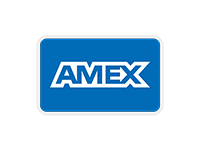By Kevin J. Holland (2014 and 2017)
Portions of the following are excerpted, with permission, from Canadian National Railways Diesel Locomotives, Vol. 2 (CNRHA, 2014).
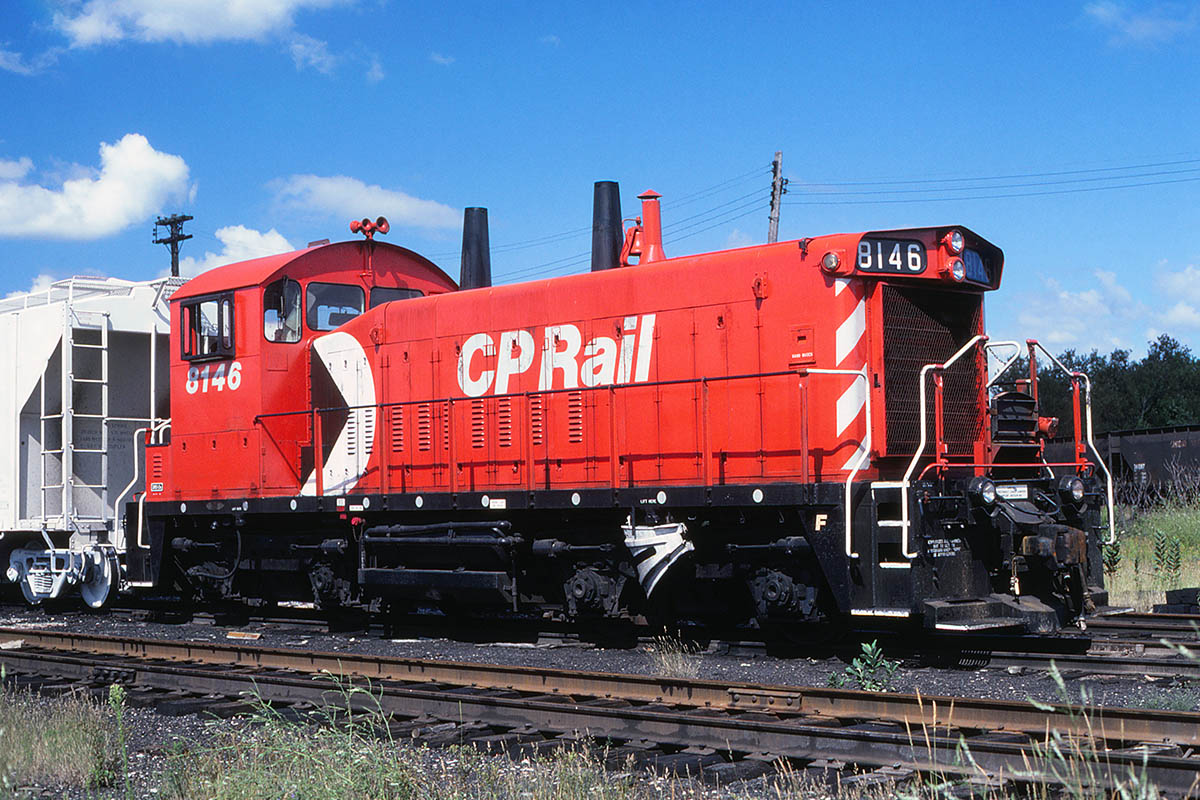
CP SW1200RS 8146 at Guelph Jct, Ontario in 1979. Fred Gaines photo/Kaluza-Mueller collection.
From Switcher to Road Switcher
General Motors Diesel (GMD) delivered the first example of what would come to be known as the SW1200RS model to Canadian National in September 1955. As its dieselization progressed, CNR needed a compact, lightweight locomotive to replace steam power on branch lines and other over-the-road assignments (freight and passenger) not requiring a full-fledged mainline road switcher. General Motors’ 1,200-hp SW1200 switcher model, in production since January 1954, combined the right size and muscle, but needed modifications for use out on the road.
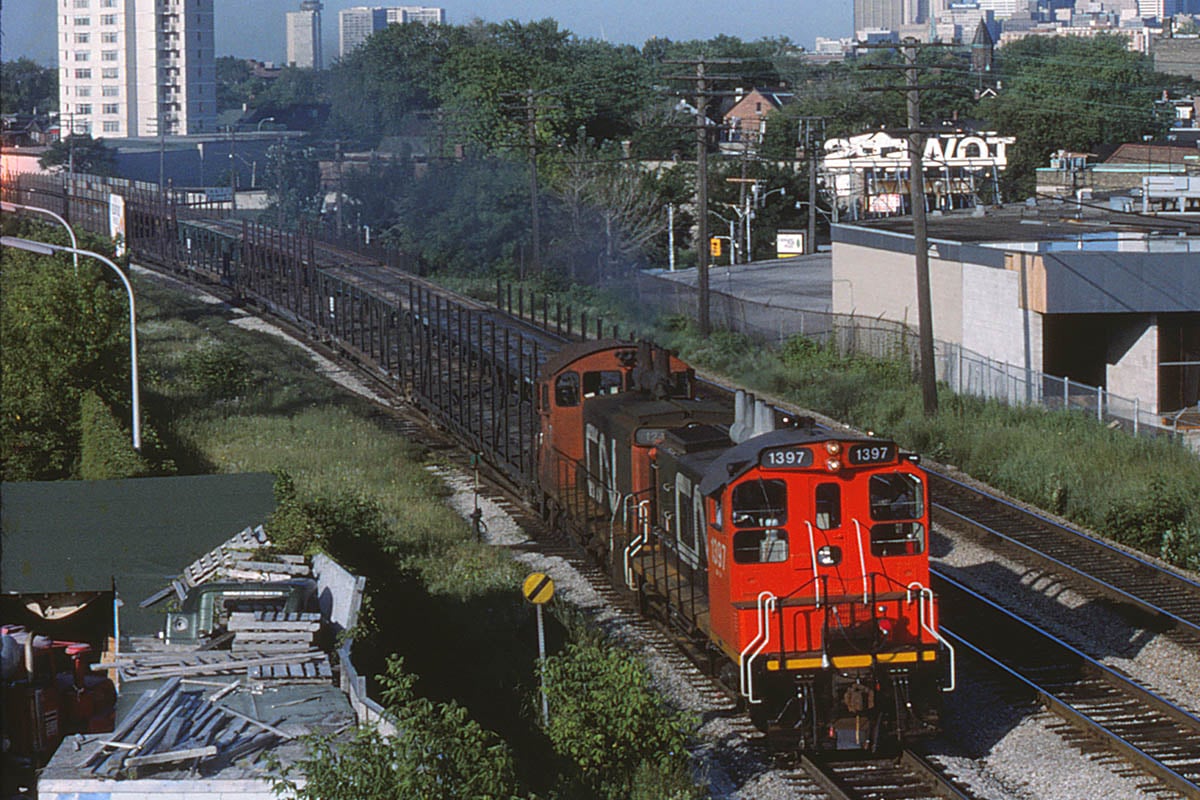
CN SW1200RS 1397 and a 1200-series sister work the grade east out of downtown Toronto, June 1982. Ted Wickson photo/Kaluza-Mueller collection.
A few months before Canadian National received its first SW1200RS, U.S. subsidiary Grand Trunk Western took delivery of four EMD SW1200 switchers, minimally modified for use as road switchers. Reflecting their intended use, the GTW SW1200 units were painted in the CNR system’s green-and-yellow road-switcher colours (yard switchers being painted solid black at the time). Solid yellow ends were a practical departure from the tapered yellow “ribbon” applied to other, more typical, CNR system road switchers. To facilitate their over-the-road assignments the GTW SW1200 units were equipped with multiple-unit control, folding end-platform drop steps, and rode on modified AAR Type A trucks. GTW Nos. 1505-1508 became Nos. 1200-1203 in CNR’s June 1956 system renumbering, and little more than a year later were assigned Nos. 1500-1503. Two more units arrived from EMD in April 1957, delivered as GTW Nos. 1269-1270 but renumbered a few months later to 1509-1510. A final group of nine GTW SW1200 units, Nos. 1511-1519, was delivered in March 1960 to help bring down the final curtain on GTW steam. Several of these GTW units subsequently were reassigned to the Central Vermont Railway, another of CNR’s U.S. subsidiaries.
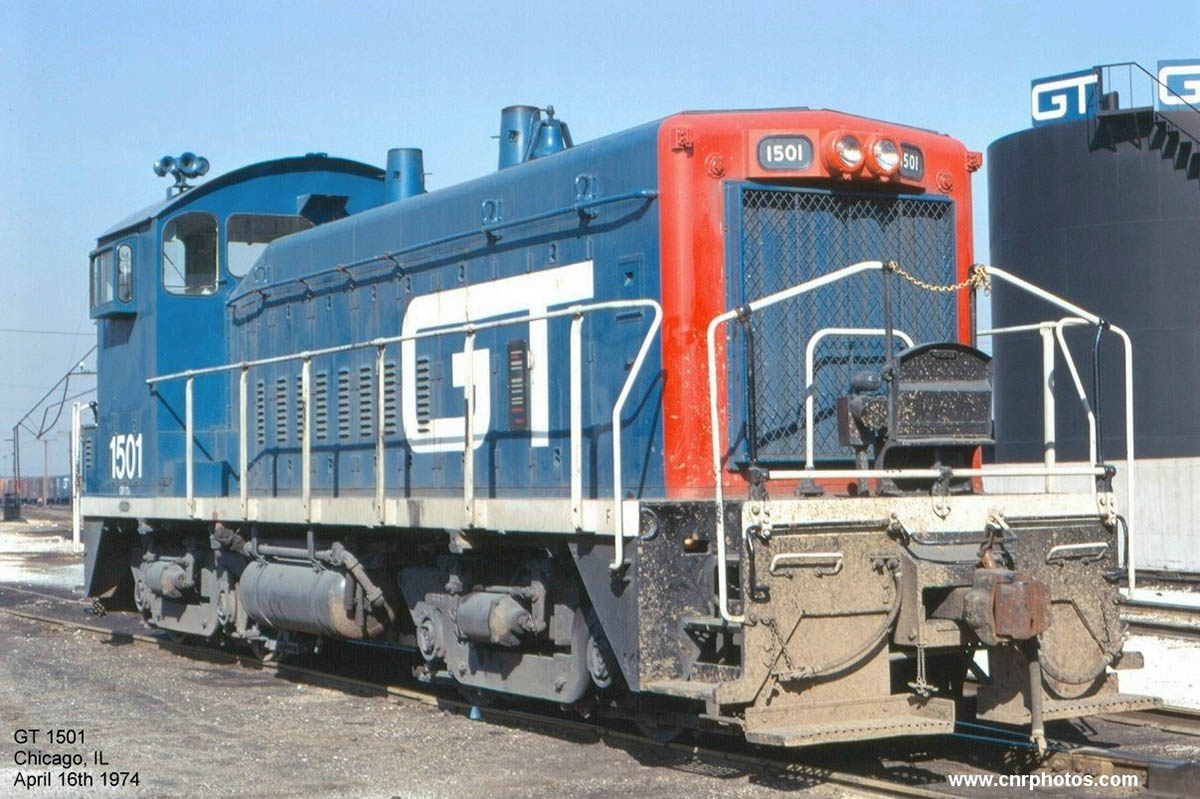
GTW SW1200 1501 at Chicago, Illinois in 1974. Note the dual hood and frame-mounted handrails. Ray Lackemeyer photo/CNRphotos.com.
As produced for Canadian National, GMD’s SW1200RS differed from the standard SW1200 by having distinctive Flexicoil trucks (a GM design offering improved suspension and ride quality versus the standard Type-B switcher truck); 62:15 gearing for a 65-mph top speed; multiple-unit capability; and large headlight/numberboard fixtures on both ends. A 775-gallon fuel tank – vs. 500 gallons on a comparable GMD yard switcher – helped CNR’s SW1200RS units venture beyond yard limits. Some features typical of switchers remained – no electric alternator, mechanically-driven traction-motor blowers and cooling fan, and hoodtop-mounted radiators with a shuttered air inlet on the front face of the hood. Retaining this cooling configuration was a deficiency of the SW1200’s adaptation to road-switcher service, since it could result in less-than-ideal ventilation through the large hood-end intake when the units were operating cab forward. As with the standard SW1200, GM’s 12-cylinder 567C engine provided the model’s 1,200 hp.
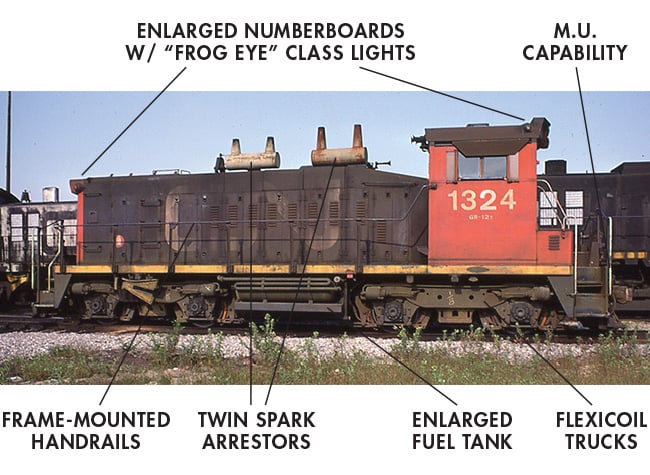
Despite its considerable customization for road-switcher duty, neither GMD nor CNR accorded this model any special designation — SW1200 sufficed in official records, despite the potential for confusion with the basic SW1200 yard switcher. As far as CNR was concerned, the difference was adequately addressed in the railway’s official class designations for the two models: GR-12 for the road switchers and GY-12 for the yard switchers.
Unofficially, though, the road-switcher variant came to be known as the SW1200RS. While at GMD’s London, Ont., plant conducting research for his book Locomotives From London (UCRS, 1968), the late Peter Cox sought to clarify production quantities for the SW1200, because out of the total number built by GMD only a few were purely switchers; the majority were multi-purpose road switchers. Cox suggested SW1200RS as a model designation for the Canadian road-switcher variant and GMD staff concurred, although neither the builder nor CN revised their official records. Railway historians and modellers adopted Cox’s unofficial model designation, and it remains in use.
Canadian National
CNR acquired a total of 192 SW1200RS units between 1955 and 1960. Assigned Nos. 1593-1597, Canadian National’s first five SW1200RS units were all in service by February 1956; within four months, they had been renumbered as 1222-1226. They were renumbered again, in August 1957, as CNR Nos. 1504-1508. They were joined by 18 identical units, delivered between March and May 1956 as CNR Nos. 1575-1592; this group was renumbered as 1204-1221 in mid-1956, ahead of the number block briefly occupied by their slightly older siblings. Their railway class identification also was out of delivery sequence, with former Nos. 1222-1226 designated as class GR-12e, while the newer group was designated GR-12d.
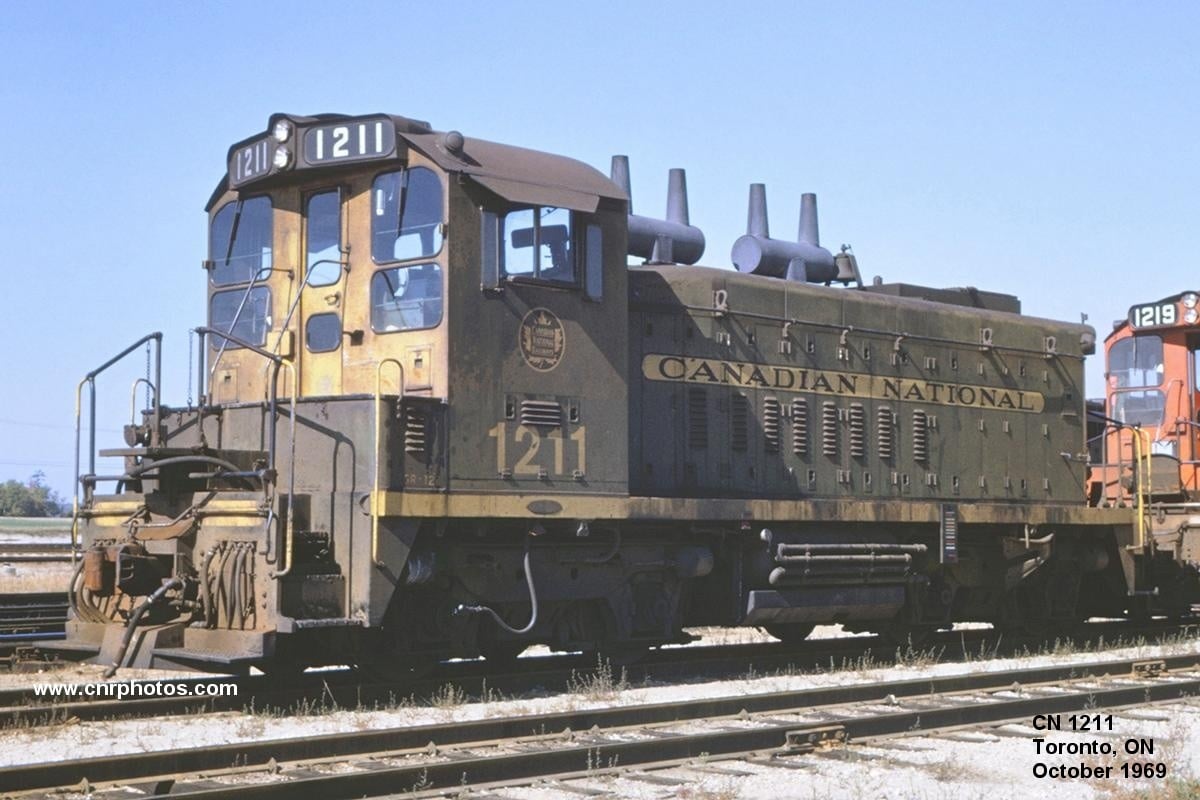
CN 1211, part of the original group of units (1204-1226) seen here in Toronto in 1971. Note it still retains its as-delivered body-mounted handrails. Don Jaworski photo/CNRphotos.com.
CNR’s diesel locomotive classification system used an alpha-numeric shorthand to summarize a locomotive’s builder (in this case, “G” for General Motors); type of service (here, “R” for road switcher); and a two-digit horsepower figure (“12” for 1,200 hp). The system didn’t distinguish between locomotive models, however, with the result that the GR-12 class was a catch-all for five different 1,200-hp General Motors road-switcher models: the SW1200, SW1200RS, GMD-1, NF110 and NF210 (the latter two being narrow-gauge models built for Newfoundland service).
A further 21 SW1200RS units completed by GMD between May and September 1956 were delivered under CNR’s revised numbering scheme as Nos. 1227-1247 (class GR-12f). This group originally was to have been Nos. 2300-2320 under the soon-to-be-revised numbering system, and some sources suggest that the first two units were indeed numbered 2300-2301 at delivery.
Most of CNR’s SW1200RS fleet was built with hood-mounted handrails. These were later replaced with frame-mounted stanchions and handrails.
In November 1956, beginning with Nos. 1248-1268 (class GR-12h), GMD altered the position of ventilation louvres on the SW1200RS hood doors. This led to a revised lettering layout in the units’ original green-and-yellow livery, with the Canadian National name moved up from its previous location to a position just below the top of the hood. Shortly after this change, the yellow frame stripe, which had extended to the step wells, was shortened and given rounded ends.
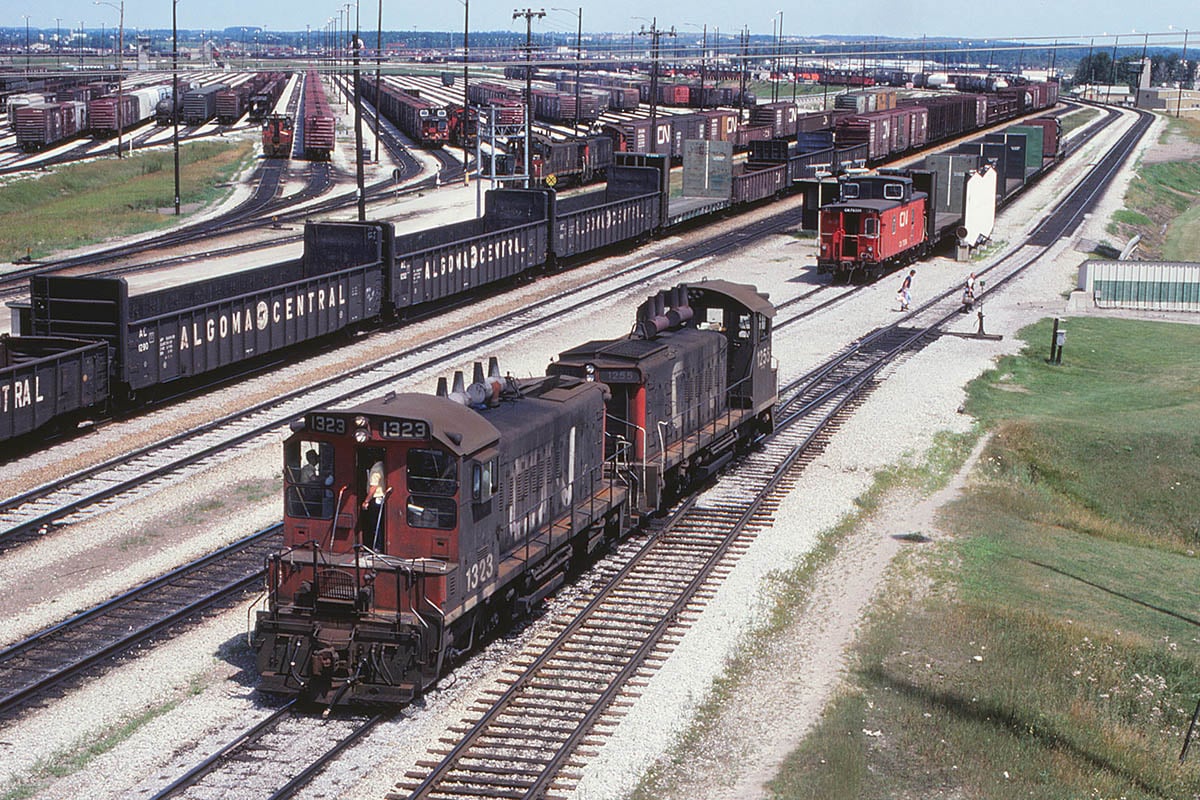
CN 1323 and 1255 illustrate variations in the hood design. MacMillan (Toronto) Yard, July, 1980. Kaluza-Mueller collection.
Another carbody change made around this time affected the access door on the right-hand lower cab side. Originally a square panel providing servicing access to the rear truck’s traction-motor blower, the ventilated opening was widened on class GR-12k and subsequent construction.
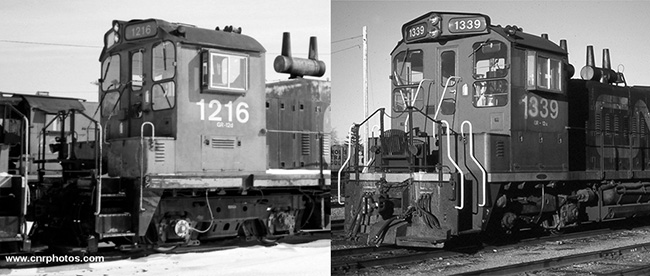
Differences in cab-side traction motor blower access hatches on early (left) and later (right) models. CNRPhotos.com/Brian Schuff collection.
Gothic-style cab-side numerals were applied by GMD to CNR’s first three SW1200RS orders. No. 1248 and subsequent units were delivered with Roman-style numerals. With a numbering gap caused by the pair of EMD SW1200 units delivered as GTW Nos. 1269-1270 in April 1957, CNR SW1200RS deliveries continued with Nos. 1271-1288 (class GR-12k) between August and November 1957, followed by Nos. 1289-1304 (GR-12l) during the first five months of 1958.
GMD made a cosmetic change to the model’s headlight/numberboard assembly commencing with CNR No. 1289 in January 1958, angling the visor upward to a shallow peak and thereby eliminating the “bump” where the headlight had formerly protruded above a horizontal visor. The outboard ends of the earlier version had also been flared into the cab roof, but the modified profile made this bit of sheet-metal work unnecessary.
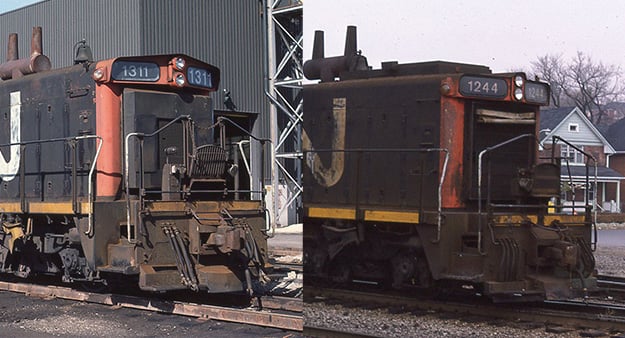
Late (left) and early (right) number board designs found on CN1200RS’s. 1289 was the first unit to get the revised design. Dan Darnell collection.
Nos. 1305-1337 (class GR-12r) were delivered in the second half of 1958. Nos. 1338-1357 (GR-12u) arrived between May and July 1959, and a final group of 40, Nos. 1358-1397 (GR-12y), was delivered between April and August 1960, coinciding with the official end of steam on Canadian National. During the course of GR-12r production, GMD changed the style of corner steps applied to the SW1200RS, from conventional platform-type steps to a pair of openings recessed into a vertical step well face.
On all CNR SW1200RS units through No. 1337, a three-chime air horn was mounted on the forward cab wall, centred below the roof edge. As delivered, CNR’s final two orders (Nos. 1338-1397) had the horns relocated to the top of the roof. All units originally had their bell mounted on top of the hood, in front of the forward exhaust stack.
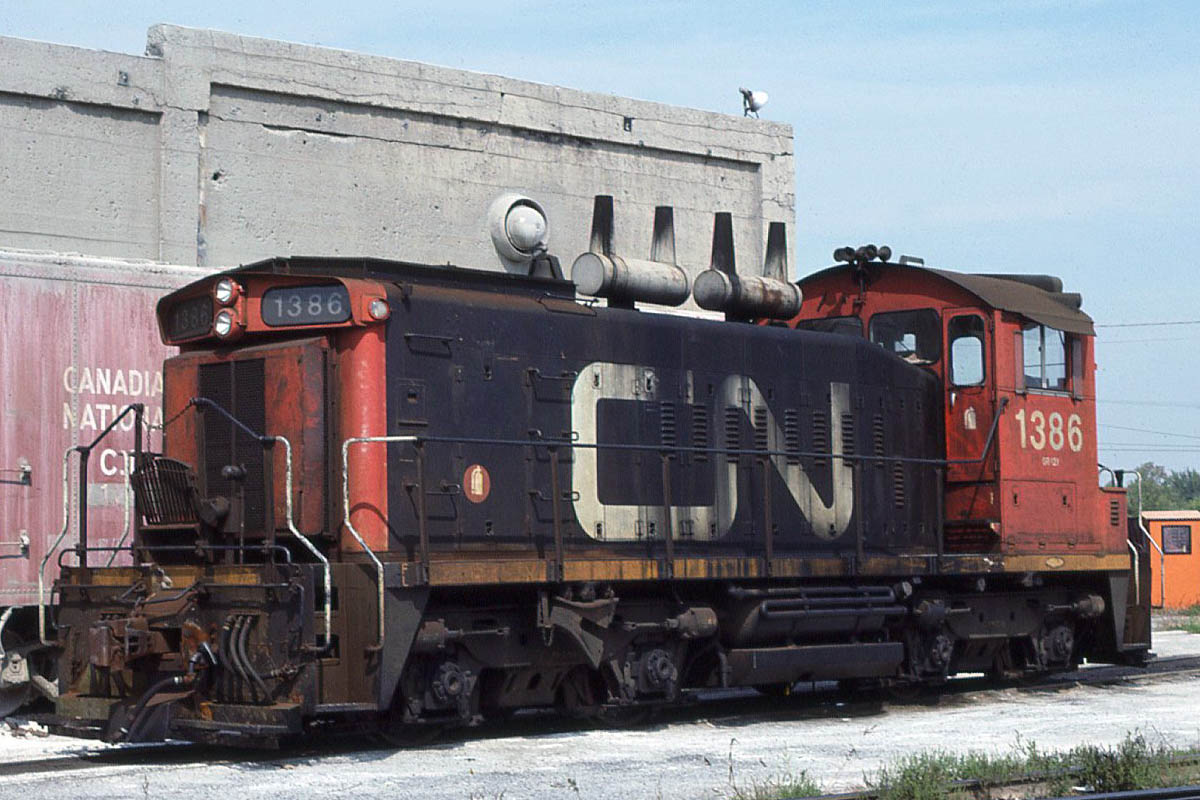
CN 1386 shows the higher horn position on later as-delivered units (1338-1397). Frank Ferguson photo/Brian Schuff collection.
The most prominent alteration to the SW1200RS profile came with the application of CNR’s distinctive centrifugal spark arrestors. In common with CNR’s “standard” GMD switcher models, these silver-painted fixtures, bolted to the manifolds where they emerged from the hood, replaced the builder’s conical exhaust stacks. Nos. 1338-1397 were delivered with these spark arrestors, and the earlier units were retrofitted by CNR. The most common version of spark arrestor applied to CNR’s SW1200RS units featured a pair of tall, tapered exhaust stacks offset atop a horizontal cylinder, but minor variations in stack height and taper (or lack thereof, as on the first examples delivered by GMD) did appear on some units.
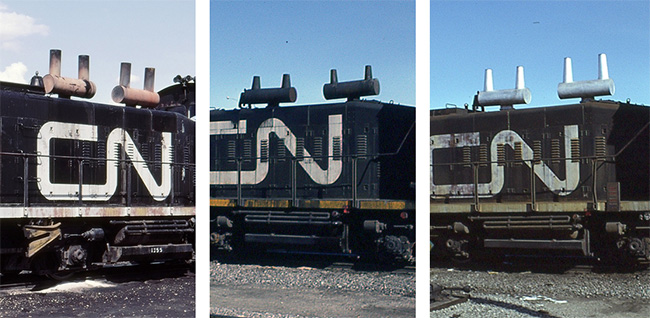
Three spark arrestor stack variants found on CN units (from L to R): Straight, Stubby and Tapered. CNRphotos.com/Brian Schuff collection.
CNR’s SW1200RS fleet ranged throughout mainland Canada. Although used principally in freight service, with the aid of a steam-generator car they could also be seen in secondary passenger and mixed-train service into the early VIA Rail Canada era.
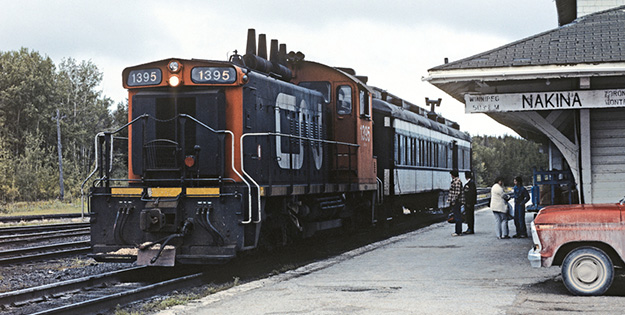
CN 1395 might struggle with this long passenger train at Nakina, Ontario. Kevin J. Holland collection.
While they were acquired for mainline and branchline road service, over time many of them were demoted to yard service — their road duties having been taken over by larger, and generally older (but rebuilt) road engines, which in turn had been superseded by larger second-generation power.
The first two Canadian National SW1200RS units to be reclassified, Nos. 1220 and 1221, were renumbered 425-426 in 1979. Assigned class GH-12d at that time for hump service, they became GY-12d units in 1983.
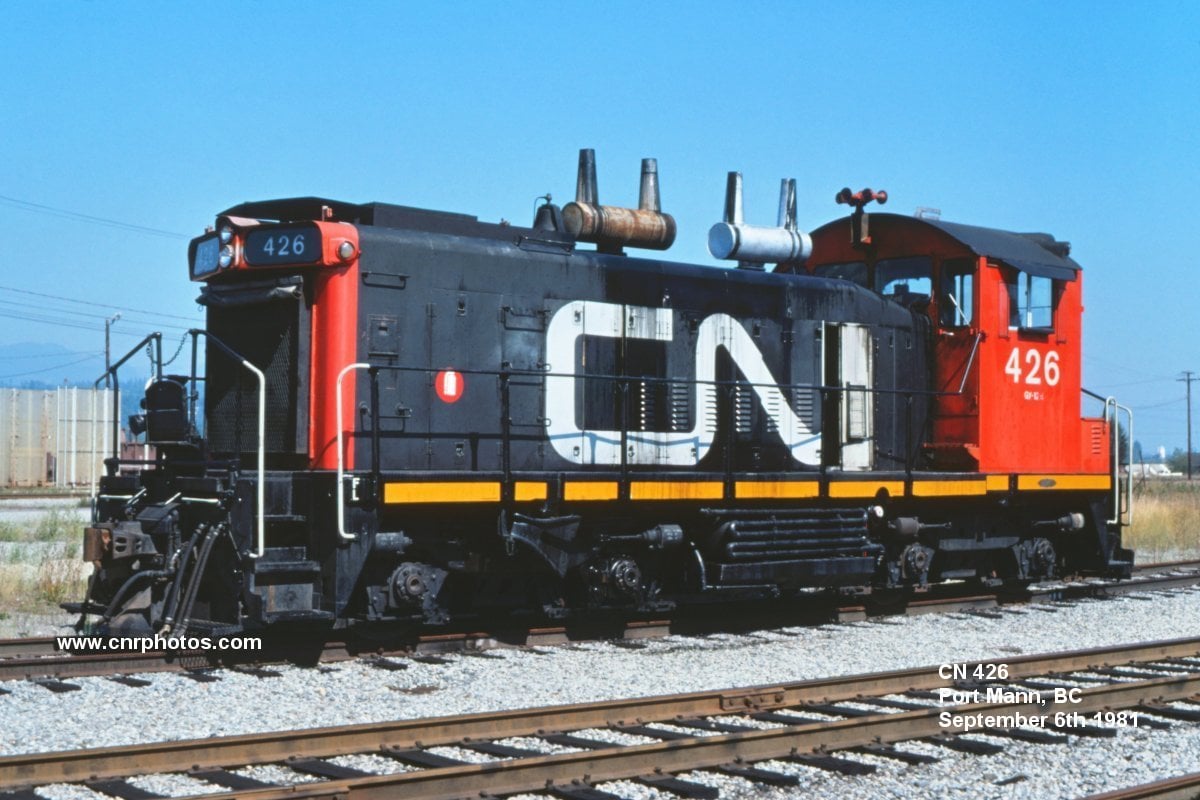
CN 426 (ex 1221) in Port Mann, BC in 1981. Sid Elliott photo/CNRphotos.com.
Canadian Pacific
Between April 12 and 20, 1957, CNR SW1200RS No. 1257 was loaned to Canadian Pacific for evaluation out of Winnipeg, as CPR accelerated its dieselization timetable and sought an effective “Branch Line Unit” (BLU) for service on low-density secondary lines. This testing led to placement of CPR’s first order for this model, 31 units delivered by GMD between June and October 1958 as Nos. 8100-8130 (class DRS-12a). They arrived in CPR’s then-standard maroon-and-grey livery with Roman lettering, although many units received script lettering prior to the introduction of the CP Rail Action Red image in 1968.
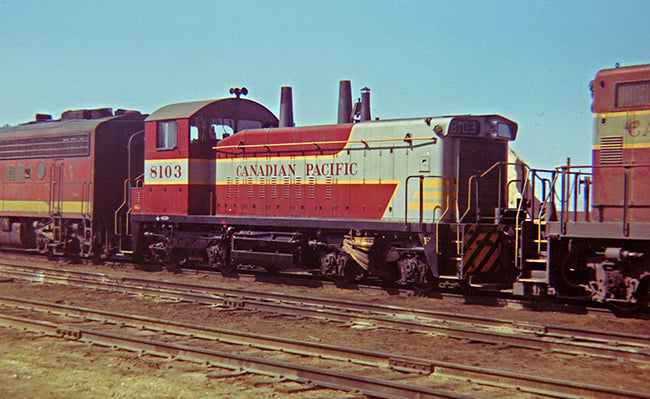
CP 8103, part of the original order of 31 units, shows it’s original appearance including body-mounted handrails. Also note the extra stack for the watchman’s heater, which not all units received. Brian Schuff collection.
Standard fixtures on CPR’s SW1200RS fleet included a three-chime air horn mounted on the forward edge of the cab roof, a Sinclair radio antenna on the cab roof centre line, and a hood-top bell in front of the forward exhaust stack. Corner steps were the later vertical recessed style also applied to CNR’s GR-12r and subsequent classes.
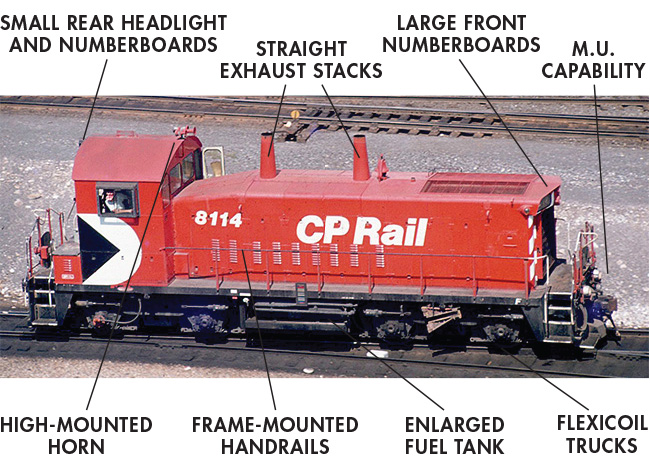
Unlike their Canadian National predecessors, CPR’s SW1200RS units were equipped with a visored headlight/numberboard assembly on the forward (hood) end only, and had a conventional small twin-sealed-beam headlight & numberboard assembly on the cab end. Production of CPR’s fleet coincided with the second version of GMD’s headlight/numberboard fixture, with an angled visor. The CPR units also lacked the “frog-eye” classification-light housings visible on the cab roofs of the CNR fleet.
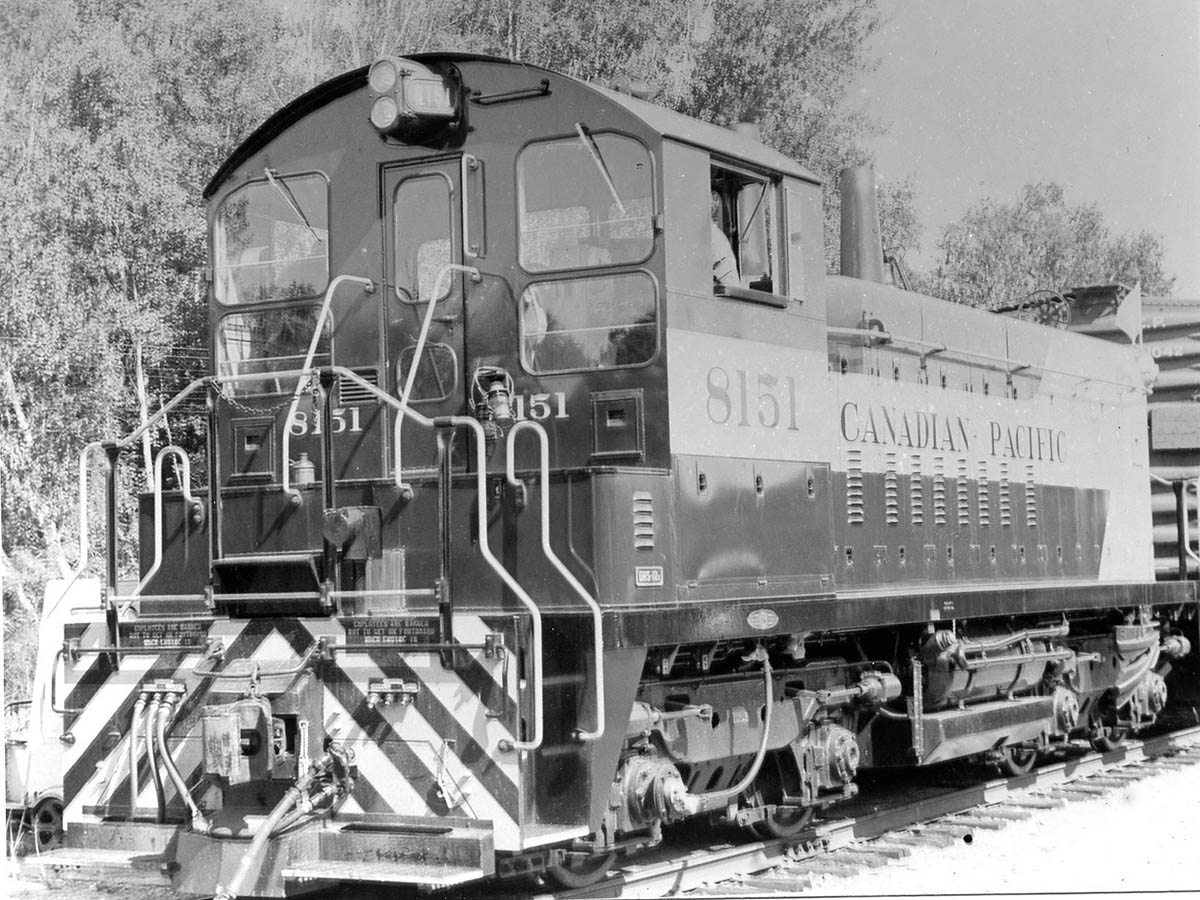
CP 8151 highlights the lack of the large rear visor assembly found on CN units. Dan Darnell collection.
CPR acquired two more groups of SW1200RS units: Nos. 8131-8146 (class DRS-12b) in the spring of 1959, and Nos. 8147-8171 (DRS-12c) in mid-1960. Among the 1959 purchase were ten units (Nos. 8131-8140) earmarked for assignment to subsidiary Dominion Atlantic Railway in Nova Scotia (but with standard CPR lettering), where they brought an end to DAR steam operation. In September 1960, SW1200RS No. 8171 had the distinction of being the final new diesel locomotive delivered as part of CPR’s dieselization. It also proved to be the final example of the model to be built.
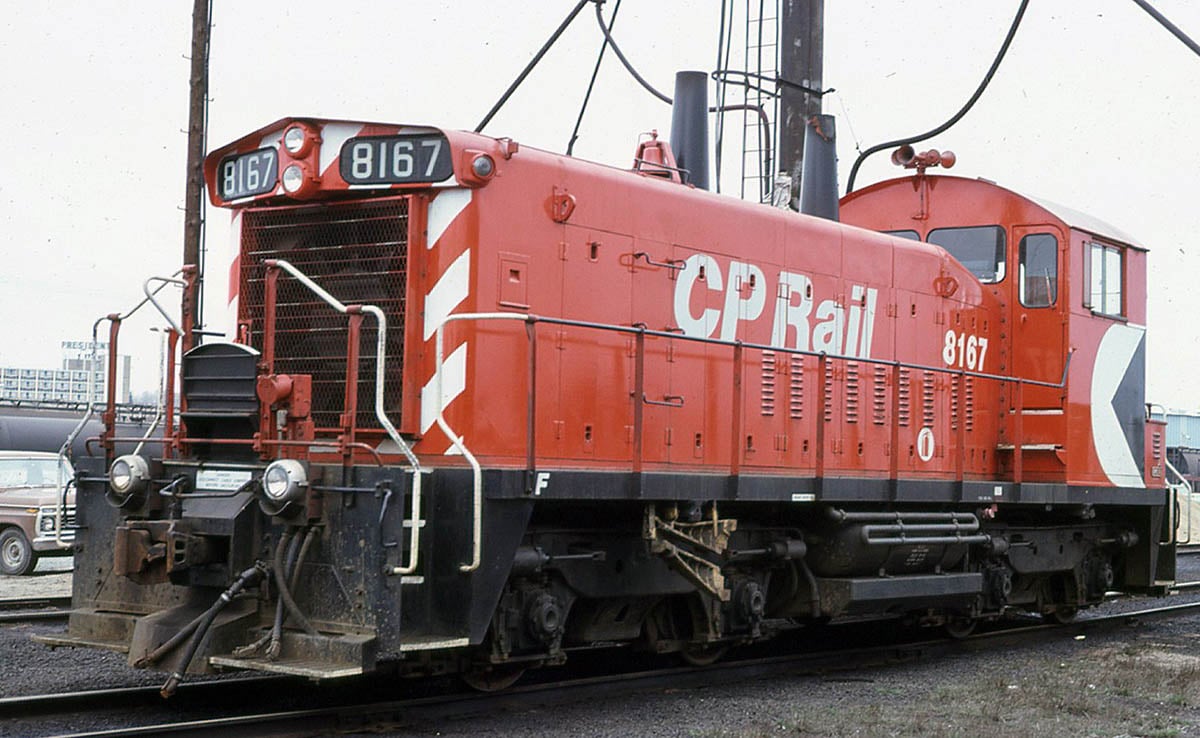
CP 8167 shows off the revised multimark scheme with 8″ end stripes and cab-side multimark. Joseph Quinn photo/Brian Schuff collection.
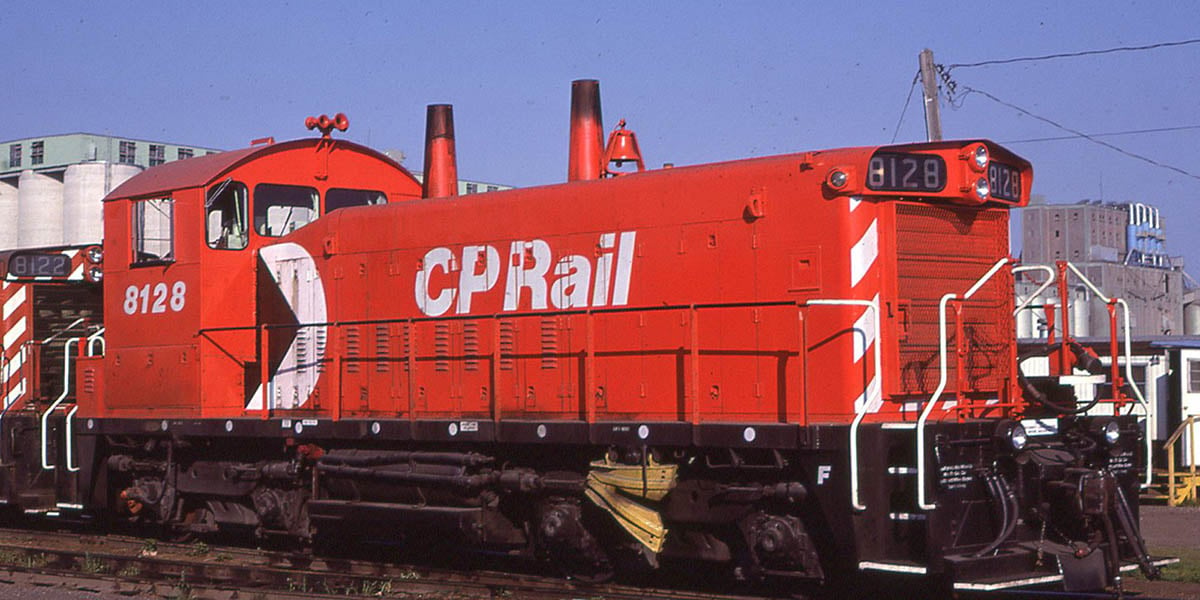
CP 8128 shows the 2nd incarnation of the 8″ stripes scheme. Note the relocated multimark, relocated numerals and simplified striping on the nose. Brian Schuff collection.
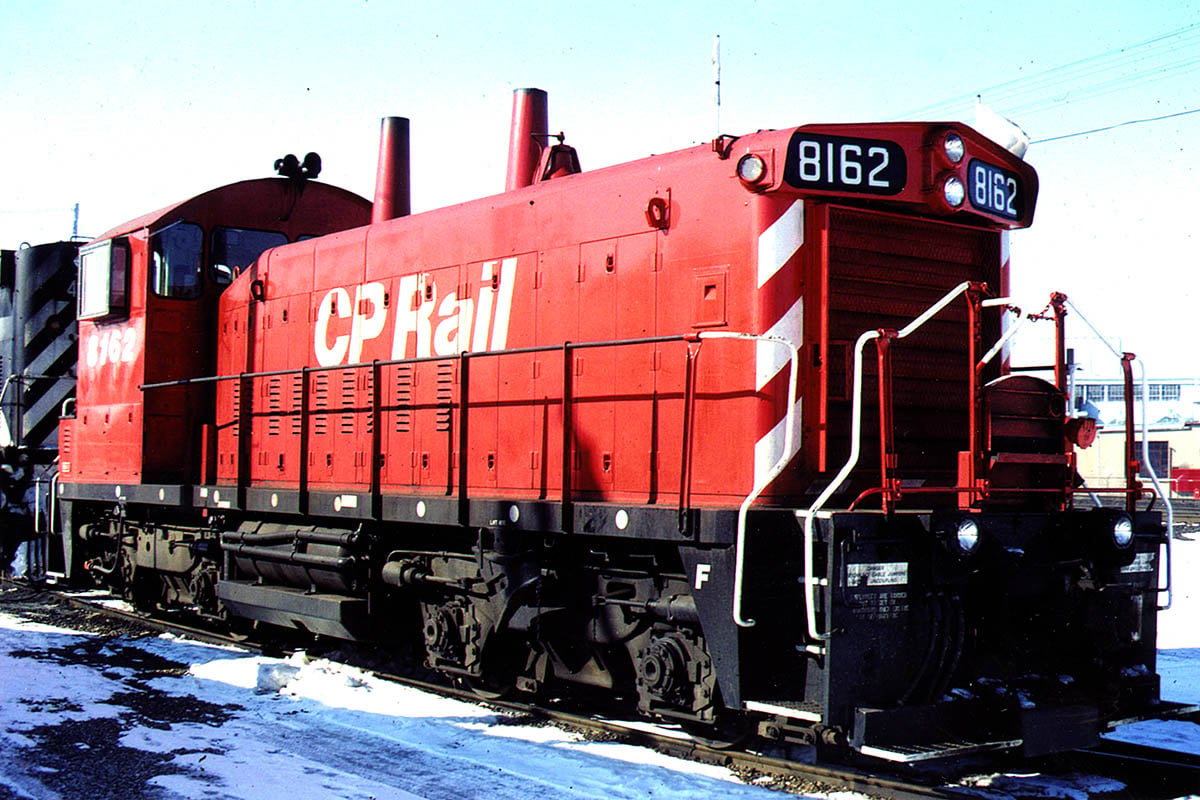
CP 8162 displays the final version of the 8″ stripe scheme without a multimark. Brian Schuff collection.
Between 1981 and 1985, CP upgraded 33 of its SW1200RS units with 645-series engine components and electrical equipment, resulting in the model designation SW1200RSu, class DS-12. The upgraded units were renumbered 1206-1214, 1237-1251, and 1268-1276.
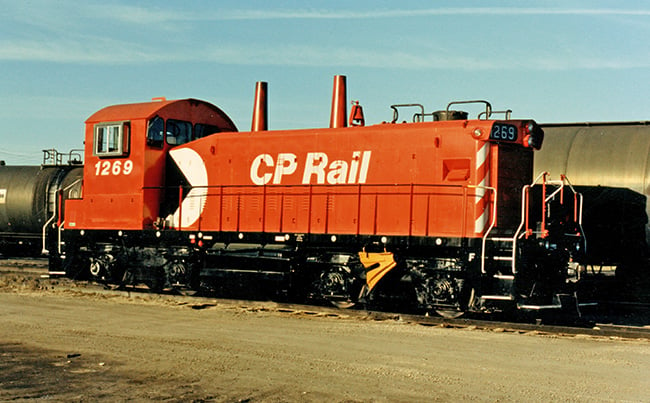
CP 1269, one of 33 upgraded units, shows off it’s relatively fresh paint. Fred Shannon photo/Brian Schuff collection.
In early 1996, four SW1200RSu units (Nos. 1246, 1269, 1271 and 1275) were rebuilt as slugs, and renumbered 1021-1024. In 1999, SW1200RSu No. 1214 was modified by CP to become hump braking unit No. 1150. In 2003 and 2004, eight SW1200RS and SW1200RSu units (Nos. 1247, 1248, 8132, 8136, 8156, 8165, 8167 and 8171) were rebuilt as yard control units (control-cab slugs) 1153-1160. Beyond renumbering, the most obvious indicator of this conversion was the plating-over of the left-hand cab-side window.
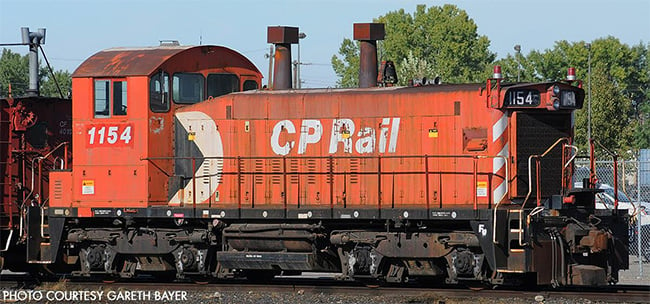
CP YCU 1154 at Calgary’s Alyth Yard in September 2011. Note the modified exhaust stacks, addition of strobe lights, and blanked-out conductors-side window. Gareth Bayer photo.
CN’s SW1200RM Remanufacturing Programs
In the mid-1980s, Canadian National was looking for ways to update its SW1200RS fleet for continued service. The first program was somewhat radical, and resulted in a locomotive that was unofficially dubbed a “Sweep.” This term was derived from the program’s combining parts from an SW1200RS (SW) and a GP9 (“Geep”) to create a new locomotive configuration: “Sweep.”
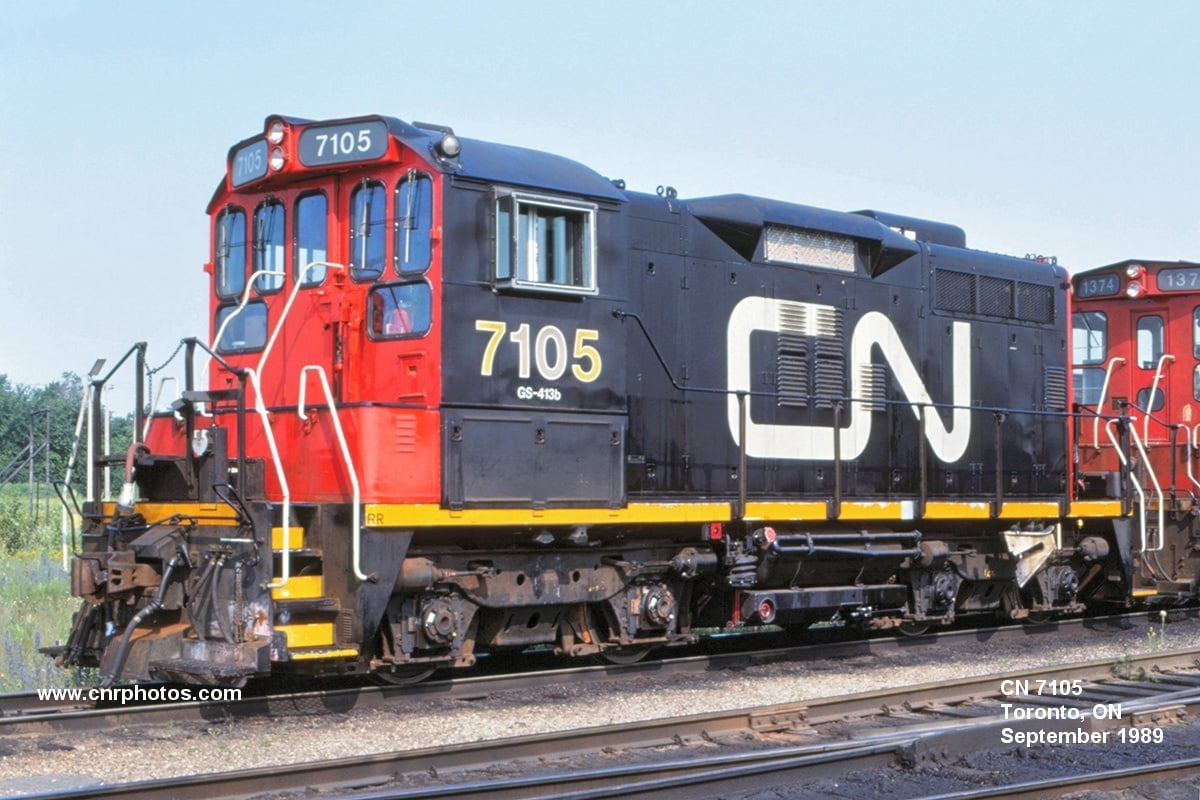
CN SW1200RM 7105 in Toronto, 1989. Don Jaworski photo/CNRphotos.com.
The SW1200RM program used an SW1200RS as the foundation for the new unit, with the result classed as GS-413a and GS-413b. The frame and cab of the SW1200RS were married to the long hood from a retired GP9. Air-intake filters were added to the inoperative dynamic-brake blister. The 12-cylinder 567C engine was upgraded with 645C components. Improved cooling capacity, thanks to the use of the larger GP9 radiators, allowed a horsepower increase to 1,300. Cabs received a modified end-window arrangement, improved insulation and heating, and a hot plate and refrigerator. The rear door was modified so that it hinged outward, providing better protection in a collision.
The first SW1200RM emerged from CN’s Pointe St. Charles (Montreal) shops in April 1986, combining the cab and frame of SW1200RS No. 1241 with the long hood from GP9 No. 4233. The first two locomotives in the series were Nos. 7300 and 7301. They were renumbered later in 1986 to Nos. 7100 and 7101, and the balance of this phase of SW1200RM production was assigned Nos. 7102-7107.
After remanufacturing eight GS-413a Sweeps between April 1986 and May 1987, CN concluded that the additional 100 horsepower gained by grafting the GP9 hood and cooling fans onto an SW1200RS did not justify the expense. After the production of eight Sweeps, CN started a simpler in-kind remanufacturing program for its SW1200RS units.
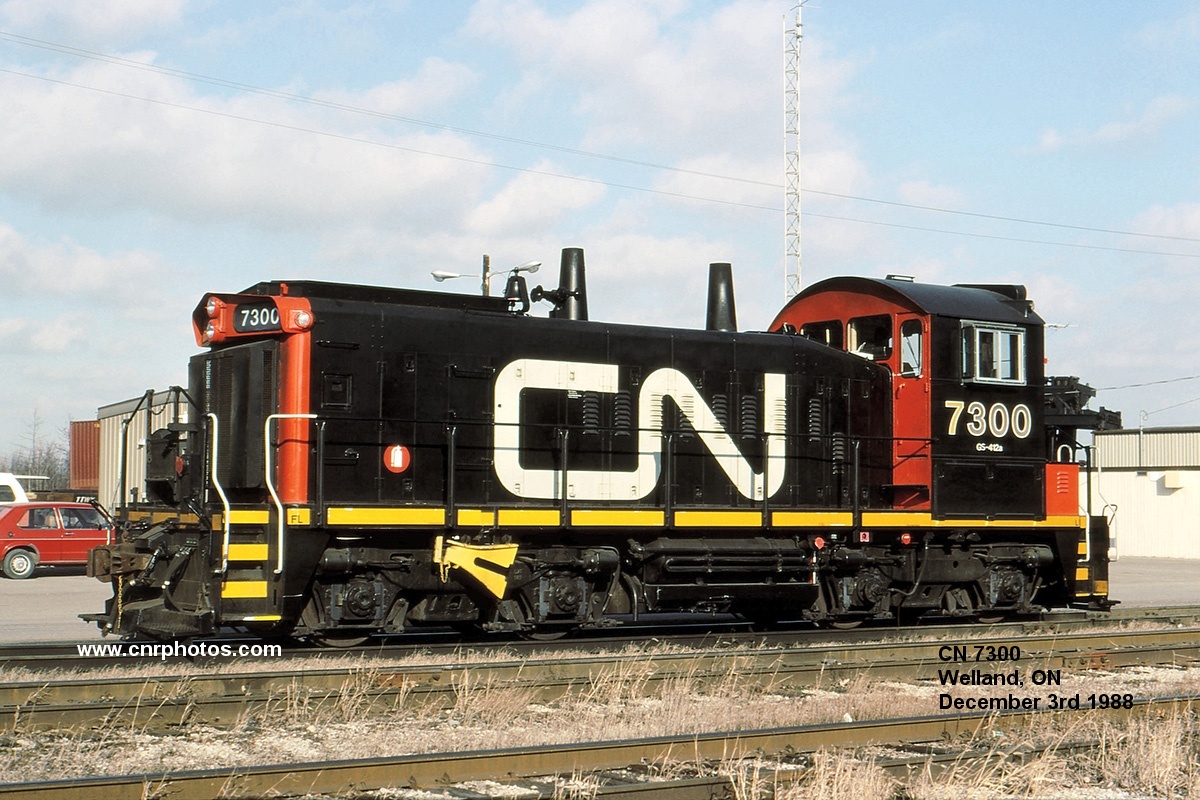
N SW1200RM 7300 in Welland, Ontario in December, 1988. Glenn Courtney photo/CNRphotos.com.
Between June and November 1987, Pointe St. Charles completed 18 SW1200RM locomotives, Nos. 7300-7317, class GS-412a. There were only minor changes to the external appearance of these rebuilt units. The most notable changes were the elimination of the barrel-shaped external spark arrestors and the application of CN’s remanufactured-switcher paint scheme with grey-outlined gold-coloured road numbers on the cab. Internally a 645C engine replaced the original 567 prime mover, but the 1,200 h.p. rating was retained. Cab upgrades included a hot plate and refrigerator and improved heating. CN’s SW1200RM fleet worked almost exclusively in southern Ontario.
The SW1200RM remanufacturing program ended with No. 7317. CN required higher-horsepower switchers, and, instead of rebuilding more SW1200RS units, increased the scope of the switcher and booster-unit phases of its GP9 remanufacturing program.


